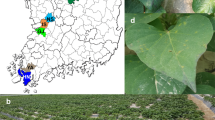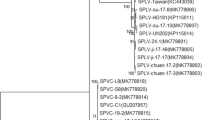Abstract
Several potyviruses are found infecting sweet potato (Ipomoea batatas) in Peru, of which sweet potato feathery mottle virus (SPFMV, genus Potyvirus) is the most common. However, sequence data for these viruses are not available from Peru. In this study, the 3′-terminal ∼1,800 nucleotide sequences of 17 potyvirus samples collected from the six main sweet potato-producing areas of Peru over the past 20 years were determined and analyzed. Results of sequence comparisons and phylogenetic analysis showed that three of the four recognized SPFMV strain groups, including the East African strain, are established in Peru as well as two other potyviruses: sweet potato virus G (SPVG) and sweet potato virus 2 (SPV2). The analysis further revealed that SPFMV, SPVG and SPV2 are related and form an Ipomoea-specific phylogenetic lineage within the genus Potyvirus and identified for the first time recombination events between viruses from different strain groups of SPFMV.




Similar content being viewed by others
References
Adams MJ, Antoniw JF, Fauquet CM (2005) Molecular criteria for genus and species discrimination within the family Potyviridae. Arch Virol 150:459–479
Aleman-Verdaguer M-E, Goudou-Urbino C, Dubern J, Beachy RN, Fauquet C (1997) Analysis of the sequence diversity of the P1, HC, P3, NIb and CP genomic regions of several yam mosaic potyvirus isolates: implications for the intraspecies molecular diversity of potyviruses. J Gen Virol 78:1253–1264
Alemu T (2004) Characterisation of viruses of pepper (Capsicum spp.) and sweet potato (Ipomoea batatas) from Ethiopia (in German). PhD thesis, University of Bonn, p 126
Ateka EM, Barg E, Njeru RW, Lesemann DE, Vetten HJ (2004) Further characterization of ‘sweet potato virus 2’: A distinct species in the genus Potyvirus. Arch Virol 149:225–239
Ateka EM, Njeru RW, Kibaru AG, Kimenju JW, Barg E, Gibson RW, Vetten HJ (2004) Identification and distribution of viruses infecting sweet potato in Kenya. Ann Appl Biol 144:371–379
Ateka EM, Barg E, Njeru RW, Thompson G, Vetten HJ (2007) Biological and molecular variability among geographically diverse isolates of sweet potato virus 2. Arch Virol 152:479–488
Bousalem M, Dallot S, Fuji S, Natsuaki KT (2003) Origin, world-wide dispersion, bio-geographical diversification, radiation and recombination: an evolutionary history of Yam mild mosaic virus (YMMV). Infect Genet Evol 3:189–206
Bousalem M, Douzery EJ, Fargette D (2000) High genetic diversity, distant phylogenetic relationships and intraspecies recombination events among natural populations of Yam mosaic virus: a contribution to understanding potyvirus evolution. J Gen Virol 81:243–255
Carey EE, Gibson RW, Fuentes S, Machmud M, Mwanga ROM, Turyamureeba G, Zhang L, Ma D, Abo El-Abbas F, El-Bedewy R, Salazar LF (1999) The causes and control of virus diseases of sweet potato in developing countries: is sweetpotato virus disease the main problem?. In: Impact on a changing world, Program Report 1997–1998. The International Potato Center, Lima, Peru, pp 241–248
Cedano C, Fuentes S, Salazar LF (1989) Identification and some characteristics of sweet potato (Ipomoea batatas L.) feathery mottle virus isolated in Peru. Fitotatología 24:43–44 (abstract in Spanish)
Chavi F, Robertson AI, Verduin BJM (1997) Survey and characterization of viruses in sweetpotato from Zimbabwe. Plant Dis 81:1115–1122
Clark CA, Hoy MW (2006) Effects of common viruses on yield and quality of Beauregard sweetpotato in Louisiana. Plant Dis 90:83–88
Colinet D, Nguyen M, Kummert J, Lepoivre P (1998) Differentiation among potyviruses infecting sweet potato based on genus- and virus-specific reverse transcription polymerase chain reaction. Plant Dis 82:223–229
Desbiez C, Lecoq H (2004) The nucleotide sequence of Watermelon mosaic virus (WMV, Potyvirus) reveals interspecific recombination between two related potyviruses in the 5′ part of the genome. Arch Virol 149:1619–1632
Di Feo L, Nome SF, Biderbost E, Fuentes S, Salazar LF (2000) Etiology of sweet potato chlorotic dwarf disease in Argentina. Plant Dis 84:35–39
Gibbs A, Mackenzie A (1997) A primer pair for amplifying part of the genome of all potyvirids by RT-PCR. J Virol Methods 63:9–16
Gibson RW, Mpembe I, Alicai T, Carey EE, Mwanga ROM, Seal SE, Vetten HJ (1998) Symptoms, aetiology and serological analysis of sweet potato virus disease in Uganda. Plant Pathol 47:95–102
Glais L, Tribodet M, Kerlan C (2002) Genomic variability in Potato potyvirus Y (PVY): evidence that PVYNW and PVYNTN variants are single to multiple recombinants between PVYO and PVYN isolates. Arch Virol 147:363–378
Glasa M, Palkovics L, Kominek P, Labonne G, Pittnerova S, Kudela O, Candresse T, Subr Z (2004) Geographically and temporally distant natural recombinant isolates of Plum pox virus (PPV) are genetically very similar and form a unique PPV subgroup. J Gen Virol 85:2671–2681
Gutiérrez D, Fuentes S, Salazar LF (2003) Sweet potato virus disease (SPVD): Distribution, incidence, and effect on sweetpotato yield in Peru. Plant Dis 87:297–302
IsHak JA, Kreuze JF, Johansson A, Mukasa SB, Tairo F, Abo El-Abbas FM, Valkonen JPT (2003) Some molecular characteristics of three viruses from SPVD-affected sweet potato plants in Egypt. Arch Virol 148:2449–2460
Jordan R, Hamond J (1991) Comparison and differentiation of potyviruses isolates and identification of strain-virus-subgroup-specific and potyvirus group-common epitopes using monoclonal antibodies. J Gen Virol 72:25–36
Karyeija RF, Kreuze JF, Gibson RW, Valkonen JPT (2000) Synergistic interactions of a potyvirus and a phloem-limited crinivirus in sweet potato plants. Virology 269:26–36
Kokkinos CD, Clark CA (2006) Interactions among Sweet potato chlorotic stunt virus and different potyviruses and potyvirus strains infecting sweet potato in the United States. Plant Dis 90:1347–1352
Kreuze JF, Karyeija RF, Gibson RW, Valkonen JPT (2000) Comparison of coat protein gene sequences show that East African isolates of Sweet potato feathery mottle virus form a genetically distinct group. Arch Virol 145:567–574
Krause-Sakate R, Fakhfakh H, Peypelut M, Pavan MA, Zerbini FM, Marrakchi M, Candresse T, Le Gall O (2004) A naturally occurring recombinant isolate of Lettuce mosaic virus. Arch Virol 149:191–197
Kumar S, Tamura K, Nei M (2004) MEGA3: Integrated software for molecular evolutionary genetics analysis and sequence alignment. Brief Bioinform 5:150–163
Larsen RC, Miklas PN, Druffel KL, Wyatt SD (2005) NL-3 K strain is a stable and naturally occurring interspecific recombinant derived from Bean common mosaic necrosis virus and Bean common mosaic virus. Phytopathology 95:1037–1042
Loebenstein G, Fuentes S, Cohen J, Salazar LF (2003) Sweet potato. In: Loebenstein G, Thottappilly (eds) Virus and virus-like diseases of major crops in developing countries. Kluwer, Dordrecht, pp 223–248
López D, Salazar LF (1987) Studies on Sweet potato feathery mottle virus (SPFMV) in Peru. Fitopatología 22:40 (abstract in Spanish)
Martin DP, Williamson C, Posada D (2005) RDP2: recombination detection and analysis from sequence alignments. Bioinformatics 21:260–262
Maynard-Smith J (1992) Analyzing the mosaic structure of genes. J Mol Evol 34:126–129
Milgram M, Cohen J, Loebenstein G (1996) Effects of Sweet potato feathery mottle virus and Sweet potato sunken vein virus on sweet potato yields and rates of reinfection of virus-free planting material in Israel. Phytoparasitica 24:189–193
Mori M, Sakai J, Kimura T, Usugi T, Hayashi T, Hanada K, Nishiguchi M (1995) Nucleotide sequence analysis of two nuclear inclusion body and coat protein genes of a sweet potato feathery mottle virus severe strain (SPFMV-S) genomic RNA. Arch Virol 140:1473–1482
Moyer JW (1986) Variability among strains of sweet potato feathery mottle virus. Phytopathology 76:1126 (abstract)
Moyer JW, Abad JA (2000) Sweet potato virus isolation, indentification and detection: 20 years later. In: Nakasawa Y, Ishiguro K (eds) International workshop on sweet potato cultivar decline study. Miyakonojo, Japan, pp 90–98
Moyer JW, Kennedy GG, Abou-Ghadir MF (1980) Identification of two sweet potato feathery mottle virus strains in North Carolina. Plant Dis 64:762–764
Mukasa SB, Rubaihayo PR, Valkonen JPT (2006) Interactions between a crinivirus, an ipomovirus and a potyvirus in coinfected sweetpotato plants. Plant Pathol 55:458–467
Nakashima JT, Salazar LF, Wood KR (1993) Sweet potato feathery mottle potyvirus (C1 isolate) virion and RNA purification. J Virol Methods 44:109–116
Njeru RW, Mburu MWK, Cheramgoi E, Gibson RG, Kiburi ZM, Obudho E, Yobera D (2004) Studies on the physiological effects of viruses on sweet potato yield in Kenya. Ann Appl Biol 145:71–76
Ohshima K, Tomitaka Y, Wood JT, Minematsu Y, Kajiyama H, Tomimura K, Gibbs AJ (2007) Patterns of recombination in turnip mosaic virus genomic sequences indicate hotspots of recombination. J Gen Virol 88:298–315
Querci M, Fuentes S, Salazar LF (1992) Construction, cloning and use of radioactive RNA probes for the detection of the Peruvian strain C1 of sweet potato feathery mottle virus. Fitopatología 27:93–97
Rossel HW, Thottappilly G (1988) Complex virus diseases of sweet potato. In: Exploration, maintenance and utilisation of sweet potato genetic resources. Report of first sweet potato planning conference 1987. International Potato Center, Lima, Peru, pp 291–302
Sakai J, Mori M, Morishita T, Tanaka M, Hanada K, Usugi T, Nishiguchi M (1997) Complete nucleotide sequence and genome organization of sweet potato feathery mottle virus (S strain) genomic RNA: the large coding region of the P1 gene. Arch Virol 142:1553–1562
Schaefers GA, Terry ER (1976) Insect transmission of sweet potato disease agents in Nigeria. Phytopathology 66:642–645
Shukla DD, Ward CW, Brunt AA (1994) The Potyviridae. CAB international, Littlehampton, UK, p 516
Souto E, Sim J, Chen J, Valverde R, Clark C (2003) Properties of strains of Sweet potato feathery mottle virus and two newly recognized potyviruses infecting sweet potato in the United States. Plant Dis 87:1226–1232
Spetz C, Taboada AM, Darwich S, Ramsell J, Salazar LF, Valkonen JPT (2003) Molecular resolution of a complex of potyviruses infecting solanaceous crops at the centre of origin in Peru. J Gen Virol 84:2565–2578
Tairo F, Jones RAC, Valkonen JPT (2006) Potyvirus complexes in sweet potato: occurrence in Australia, serological and molecular resolution, and analysis of the Sweet potato virus 2 (SPV2) component. Plant Dis 90:1120–1128
Tairo F, Mukasa SB, Jones RAC, Kullaya A, Rubaihayo PB, Valkonen JPT (2005) Unraveling the genetic diversity of the three main viruses involved in Sweet Potato Virus Disease (SPVD), and its practical implications. Mol Plant Pathol 6:199–211
Untiveros M, Fuentes S, Salazar LF (2007) Synergistic interaction of Sweet potato chlorotic stunt virus (Crinivirus) with carla-, cucumo-, ipomo- and potyviruses infecting sweet potato. Plant Dis 91:669–676
Valli A, Lopez-Moya JJ, Garcıa JA (2007) Recombination and gene duplication in the evolutionary diversification of P1 proteins in the family Potyviridae, J Gen Virol 88:1016–1028
Valverde RA, Lozano G, Navas-Castillo J, Ramos A, Valdés F (2004) First report of Sweet potato chlorotic stunt virus and Sweet potato feathery mottle virus infecting sweet potato in Spain. Plant Dis 88:428
Zhong Y, Guo A, Li C, Zhuang B, Lai M, Wei C, Luo J, Li Y (2005) Identificaction of natural occurring recombinant isolate of Sugarcane mosaic virus causing maize dwarf mosaic disease. Virus Genes 30:75–83
Acknowledgments
The study was partially supported by a joint project with the University of Helsinki (Prof. J.P.T. Valkonen; grant #1110797, Academy of Finland) aiming to develop durable resistance to SPVD. We are grateful to Jari Valkonen for critical reading of the manuscript, and to Jim Moyer for providing the YV isolate of SPFMV.
Author information
Authors and Affiliations
Corresponding author
Rights and permissions
About this article
Cite this article
Untiveros, M., Fuentes, S. & Kreuze, J. Molecular variability of sweet potato feathery mottle virus and other potyviruses infecting sweet potato in Peru. Arch Virol 153, 473–483 (2008). https://doi.org/10.1007/s00705-007-0019-0
Received:
Accepted:
Published:
Issue Date:
DOI: https://doi.org/10.1007/s00705-007-0019-0




